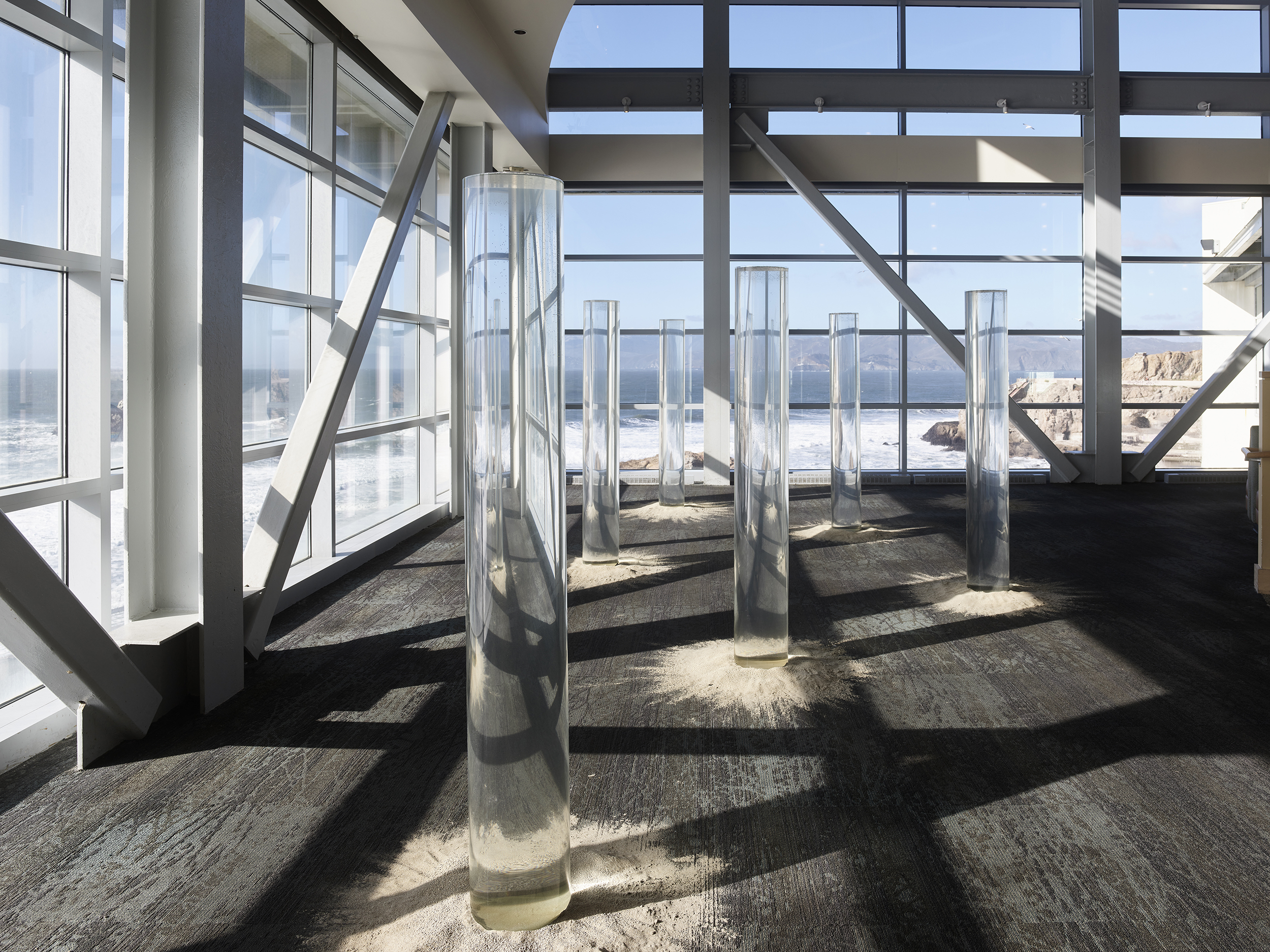Gallery of 3 photos
the slideshow
A specter is haunting the Cliff House—the specter of climate change. You can hear it emerging ominously from the building’s lower level, where restaurant staff once retreated to change clothing and tuck their belongings away in lockers: ancient glaciers crackling as they are torn apart by rising temperatures, giant waves crashing against icy shores, wind whipping across frozen wastes, and ominous noises more familiar to fish than humans.
These are the sounds of Energy Field, a sonic installation by Norwegian artist Jana Winderen, one of numerous climate-themed works currently occupying the building where San Franciscans once enjoyed dinner and drinks while overlooking the ruins of the old Sutro Baths and the rolling Pacific Ocean.
More than 150 years after the first structure was erected on what is now Point Lobos Avenue, this storied building is hosting “Lands End,” a group exhibition organized by the FOR-SITE Foundation in conjunction with the National Park Service, which owns the space. On view through March 27, 2022, “Lands End” uses each room of the neoclassical building to showcase works from 27 artists, all of which underscore some aspect of the climate crisis. In addition to Energy Field, visitors will see Andy Goldsworthy’s Geophagia, which highlights the ravages of severe drought; and Iris van Herpen’s Blue Marble Dress, which comments upon the deluge of plastics and other debris being funneled into the world’s waterways.
Winderen’s piece is one of the exhibit’s most viscerally disruptive experiences. Ordinarily, the artist installs her works in rooms that she modifies acoustically for visitors to inhabit, but at “Lands End,” Energy Field echoes up a stairwell from a place just beyond view. Visitors can walk partway down the stairs but no further. All one can see are the remaining steps and the darkened lockers below. The sound of melting ice sheets and rising tides in Greenland, Iceland, and Norway looms in the near distance.
At times, Energy Field sounds like a horror show or a kind of environmental exorcism—as if the ancient ice that Winderen met is telling her (and us, as listeners) that its sounds of tearing are a kind of environmental torture. But Winderen’s sound installation, which she made over four years and first released in 2010, also channels the incredible beauty of the unfreezing worlds she encountered.
“Iceland was my first experience with a massive glacier, and it’s where I really started to understand how these masses of ice make a lot of sound when they move,” Winderen says in a Zoom interview from her home in Norway. “They have this massive rumbling sound. And also the popping and creaking and crackling sound when the ice melts. It becomes almost like a massive, monstrous being.”
Winderen, who has exhibited at MoMA in New York and ArtBasel Miami, says the audio she captured by placing hydrophones inside or under the ice inspires dread because the sound appeals “directly to your emotions or to your associations. This is ice that’s been there for 10,000 years that has been compressed. So when it melts, it has a very potent, popping sound. You can hear the age of the ice from listening to it.”
Rather than taking a 10,000-foot political view of the climate crisis—as world leaders recently did at the United Nations Climate Change Conference in Glasgow—”Lands End” delivers personal takes on a planet poisoned by petroleum products. Instead of lectures and debates about temperature spikes, carbon markets, and methane emissions, we get a former Cliff House kitchen space that the art duo known as One Beach Plastic (Richard Lang and Judith Selby Lang) transformed into a surreal buffet of white plastic “food.” Discarded bottle caps, funnels, spouts, wiffle balls, and other detritus that the Langs found on Kehoe Beach in Point Reyes National Seashore overflow from serving trays. Maja Petrić delivers an AI-assisted and apocalyptic collage of California’s recent wildfires. And a film by Doug Aitken shows wild animals traipsing through American motel rooms—a potent visual metaphor for the way manmade environments have been imposed on the natural world.
Cheryl Haines, the founding executive director of the FOR-SITE Foundation, says she hopes the art of “Lands End” can convey ideas in epiphany-like ways that scientists and politicians cannot. “Sadly, this is an incredibly timely conversation,” says Haines, whose foundation has orchestrated such previous exhibits as “@Large: Ai Weiwei on Alcatraz.” The Cliff House was first built in 1863, and at one point was owned by Adolph Sutro, whose wealth and opulence led him to build the nearby private pool complex called Sutro Baths — a history that Haines was conscious of when she first planned the exhibit in May. “I’m interested in that history in San Francisco when Sutro Baths was constructed and there was this pursuit of indulgence and excess and an attitude of hubris,” she says. “It was a very opulent time. And that’s curious in juxtaposition to this whole conversation about limited resources and threatened food sources and disenfranchised people being forced to perhaps leave their homes due to climate change. That’s a very deep layer to this project.”
